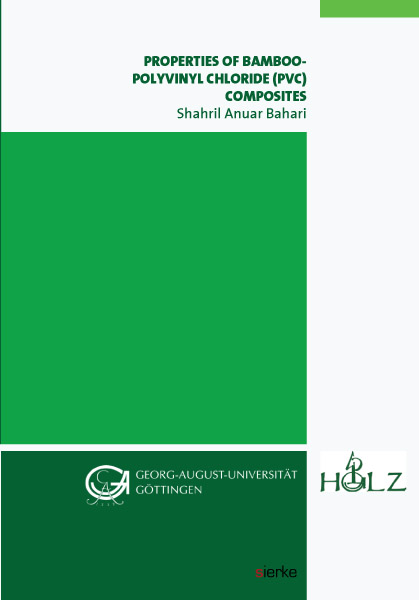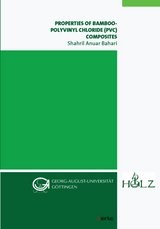PROPERTIES OF BAMBOO-POLYVINYL CHLORIDE (PVC) COMPOSITES
Seiten
2017
sierke VERLAG - Sierke WWS GmbH
978-3-86844-918-1 (ISBN)
sierke VERLAG - Sierke WWS GmbH
978-3-86844-918-1 (ISBN)
As applications for wood-plastic composites (WPC) and other thermoplastic composites are growing rapidly, the development of new alternative materials is also progressively expanding. Bamboos, with their special characteristics, are a promising resource for the WPC industry. A study was conducted to determine the impact of the basic aspects of raw materials and processing on the properties of bamboo-polyvinyl chloride (PVC) composites system and product. The composites were produced using typical processing stages for pure PVC composites products: dry blending, extrusion, and compression moulding. The Malaysian bamboo species Bambusa vulgaris and Schizostachyum brachycladum were utilized as particulate fillers, with different particles sizes and loading, as well as different processing lubricants concentrations. Experimental results indicated that chemical attributes of bamboo varied by species, and were subsequently related to the processing and performance properties of the composites. Dynamic image analysis (DIA) showed a wide distribution of bamboo particles length, with insufficient amount of actual length distribution in each particles size group for both species. Aspect ratio has been increased with bamboo particles length, although small particles were slightly elongated than larger ones. During composites processing, no significant changes were found in materials’ glass transition temperatures (Tg) between dry blending, extrusion, and compression moulding processes, nor between bamboo particles loading at the respective processing stages, indicative of the thermal stability of the processed materials. However, Tg had a tendency to decrease with the use of large bamboo particles and high lubricant concentration. The thermal decomposition temperature at 5% mass loss (T-5%) appeared to decrease with the presence of bamboo particles throughout the respective processing stages, attributable to the processing temperature and particles degradation. Bamboo-PVC composites system showed indefinitely end-point of oxidative induction time (OIT) profiles, which is suggestive of comparatively stabilized composites. Electron paramagnetic resonance (EPR) spectroscopy’s signal strength intensity is influenced by all parameters used in producing composites; viz. processing stages, bamboo particles size, bamboo particles loading, processing lubricant concentrations, as well as bamboo species. High EPR intensity is presumed to be affected by the formation of free radicals during composites processing. It is also presumed that the chemical attributes of bamboo influence free radical formation, consequently contributing to the high EPR intensity of composites system and product. Regardless of species, the incorporation of bamboo particles tremendously increased the bending elasticity and tensile elasticity of composites due to the bamboo’s stiffness. However, it simultaneously decreased resistance to water absorption, bending rupture, tensile rupture, and impact strength. Notwithstanding this, the bending properties of bamboo-PVC composites product conform to construction standards for plastic decking lumber product (ASTM D 6662). Bamboo particles size had only a minor impact on the performance of composites product in relation to insufficient actual particles length in each sieve size group. However, the use of small particles considerably improved the water resistance and impact strength of the composites. High lubricant concentrations promoted better resistance to water absorption, and provided remarkably support with regard to impact strength of composites. Fatigue mechanical property showed that bamboo-PVC composites product had a notable fatigue life ascribable to bamboo stiffness resistance. The number of cycles-to-failure at each stress level was greatly higher for product using small particles size with less particles loading. The presence of bamboo particles in composites improved the storage modulus (E’) and reduced damping parameters (tan δ) throughout dynamic mechanicalthermal analysis (DMTA) in accordance to the stiffness effects of bamboo particles. No significant impacts from bamboo particles size and processing lubricants concentration were observed for the DMTA properties of composites. With most of the properties of bamboo-PVC composites being compatible with pure PVC composites and wood-PVC composites, their successful production will serve the polymer composites and WPC industries.
| Erscheinungsdatum | 19.07.2017 |
|---|---|
| Verlagsort | Göttingen |
| Sprache | englisch |
| Maße | 1480 x 2100 mm |
| Gewicht | 240 g |
| Themenwelt | Naturwissenschaften ► Chemie ► Anorganische Chemie |
| Weitere Fachgebiete ► Land- / Forstwirtschaft / Fischerei | |
| Schlagworte | Bamboo • Composites • Eco-Product Technology • PVC |
| ISBN-10 | 3-86844-918-3 / 3868449183 |
| ISBN-13 | 978-3-86844-918-1 / 9783868449181 |
| Zustand | Neuware |
| Haben Sie eine Frage zum Produkt? |
Mehr entdecken
aus dem Bereich
aus dem Bereich




